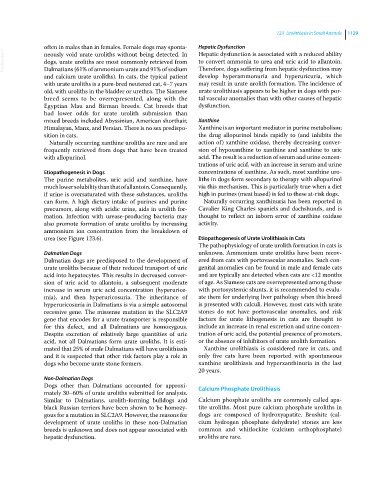Page 1191 - Clinical Small Animal Internal Medicine
P. 1191
123 Urolithiasis in Small Animals 1129
often in males than in females. Female dogs may sponta Hepatic Dysfunction
VetBooks.ir neously void urate uroliths without being detected. In to convert ammonia to urea and uric acid to allantoin.
Hepatic dysfunction is associated with a reduced ability
dogs, urate uroliths are most commonly retrieved from
Therefore, dogs suffering from hepatic dysfunction may
Dalmatians (61% of ammonium urate and 91% of sodium
and calcium urate uroliths). In cats, the typical patient develop hyperammonuria and hyperuricuria, which
with urate uroliths is a pure‐bred neutered cat, 4–7 years may result in urate urolith formation. The incidence of
old, with uroliths in the bladder or urethra. The Siamese urate urolithiasis appears to be higher in dogs with por
breed seems to be overrepresented, along with the tal vascular anomalies than with other causes of hepatic
Egyptian Mau and Birman breeds. Cat breeds that dysfunction.
had lower odds for urate urolith submission than
mixed breeds included Abyssinian, American shorthair, Xanthine
Himalayan, Manx, and Persian. There is no sex predispo Xanthine is an important mediator in purine metabolism;
sition in cats. the drug allopurinol binds rapidly to (and inhibits the
Naturally occurring xanthine uroliths are rare and are action of) xanthine oxidase, thereby decreasing conver
frequently retrieved from dogs that have been treated sion of hypoxanthine to xanthine and xanthine to uric
with allopurinol. acid. The result is a reduction of serum and urine concen
trations of uric acid, with an increase in serum and urine
Etiopathogenesis in Dogs concentrations of xanthine. As such, most xanthine uro
The purine metabolites, uric acid and xanthine, have liths in dogs form secondary to therapy with allopurinol
much lower solubility than that of allantoin. Consequently, via this mechanism. This is particularly true when a diet
if urine is oversaturated with these substances, uroliths high in purines (meat based) is fed to these at‐risk dogs.
can form. A high dietary intake of purines and purine Naturally occurring xanthinuria has been reported in
precursors, along with acidic urine, aids in urolith for Cavalier King Charles spaniels and dachshunds, and is
mation. Infection with urease‐producing bacteria may thought to reflect an inborn error of xanthine oxidase
also promote formation of urate uroliths by increasing activity.
ammonium ion concentration from the breakdown of
urea (see Figure 123.6). Etiopathogenesis of Urate Urolithiasis in Cats
The pathophysiology of urate urolith formation in cats is
Dalmatian Dogs unknown. Ammonium urate uroliths have been recov
Dalmatian dogs are predisposed to the development of ered from cats with portovascular anomalies. Such con
urate uroliths because of their reduced transport of uric genital anomalies can be found in male and female cats
acid into hepatocytes. This results in decreased conver and are typically are detected when cats are <12 months
sion of uric acid to allantoin, a subsequent moderate of age. As Siamese cats are overrepresented among those
increase in serum uric acid concentration (hyperurice with portosystemic shunts, it is recommended to evalu
mia), and then hyperuricosuria. The inheritance of ate them for underlying liver pathology when this breed
hyperuricosuria in Dalmatians is via a simple autosomal is presented with calculi. However, most cats with urate
recessive gene. The missense mutation in the SLC2A9 stones do not have portovascular anomalies, and risk
gene that encodes for a urate transporter is responsible factors for urate lithogenesis in cats are thought to
for this defect, and all Dalmatians are homozygous. include an increase in renal excretion and urine concen
Despite excretion of relatively large quantities of uric tration of uric acid, the potential presence of promoters,
acid, not all Dalmatians form urate uroliths. It is esti or the absence of inhibitors of urate urolith formation.
mated that 25% of male Dalmatians will have urolithiasis Xanthine urolithiasis is considered rare in cats, and
and it is suspected that other risk factors play a role in only five cats have been reported with spontaneous
dogs who become urate stone formers. xanthine urolithiasis and hyperxanthinuria in the last
20 years.
Non‐Dalmatian Dogs
Dogs other than Dalmatians accounted for approxi Calcium Phosphate Urolithiasis
mately 30–60% of urate uroliths submitted for analysis.
Similar to Dalmatians, urolith‐forming bulldogs and Calcium phosphate uroliths are commonly called apa
black Russian terriers have been shown to be homozy tite uroliths. Most pure calcium phosphate uroliths in
gous for a mutation in SLC2A9. However, the reasons for dogs are composed of hydroxyapatite. Brushite (cal
development of urate uroliths in these non‐Dalmatian cium hydrogen phosphate dehydrate) stones are less
breeds is unknown and does not appear associated with common and whitlockite (calcium orthophosphate)
hepatic dysfunction. uroliths are rare.

